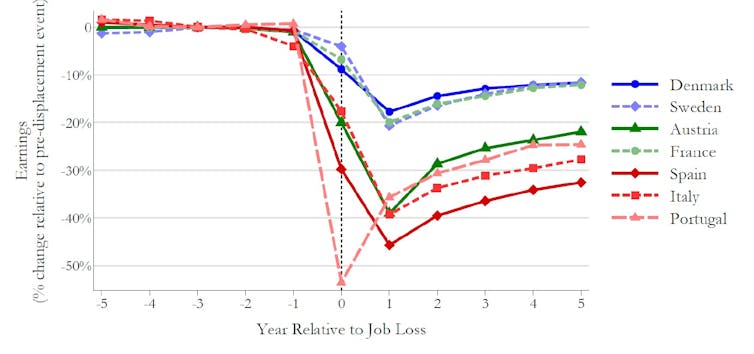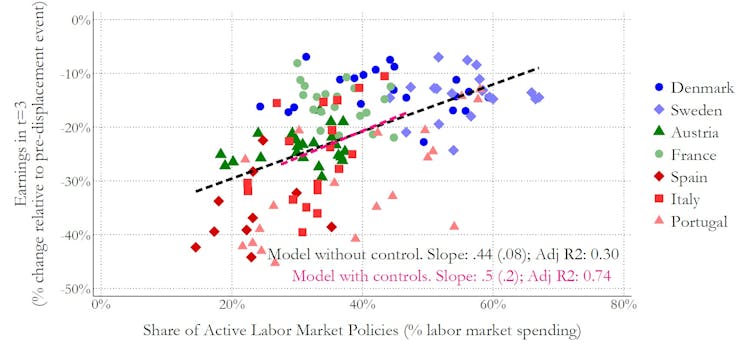
Imagine an Italian and a Danish worker who have very similar qualifications and jobs in a similar industry. Now imagine that they suddenly lose their jobs due to a mass layoff or the closure of their company. Are the consequences of being laid off different for the two workers?
We sought to answer that question by poring over data spanning seven European countries and a period from the 1980s through the 2010s. Our main takeaway is that losing one’s job has very different implications depending upon the labour market in Europe.
Unequal income losses
First, we sought to harmonise administrative records gathered by social security institutes from our seven country case studies, each of them characterised by different labour market institutions: Austria, Denmark, France, Italy, Portugal, Spain and Sweden. This proved essential for us to compare results and ensure definitions and methodologies were consistent across countries.
Second, we used a popular research strategy in economics based on the study of events to extract causal effects. That means that for each country, we identified the workers affected by a collective layoff and tracked the evolution of their main labour market outcomes – that is earnings, hourly wage and employment status – for five years before and after the job loss.
In order to gauge the impacts of job loss, we compared the employment prospects of laid-off workers with those of equivalent workers who had not been affected by a collective layoff during the same period. Both groups possessed similar demographic characteristics (age and sex), similar earnings prior to the collective layoff and similar working conditions in firms in the same industry.

The graph shows that Northern European countries have to contend with the smallest income losses by far: in the five years following the layoff, earnings are almost 10% lower than those observed prior to the event. In contrast, the earnings of workers affected by collective redundancies in Southern Europe (Italy, Portugal and Spain) are around 30% lower. Austrian workers exhibit income losses in the middle of the range between Scandinavian and Southern European countries, while French workers’ income losses are more similar to those in Northern Europe.
Southern Europe takes the hit
Much of this variation in income loss from one country to the next can be explained by different job prospects. About 20% of laid-off workers in Spain, Portugal and Italy do not find a job five years after dismissal. This percentage is only around 5% in Sweden and Denmark, and around 10% in France and Austria. Day wage losses are less dispersed across countries, with most concentrated in a range between 5% and 10% five years after job loss.
We investigated whether it is possible that laid-off employees in Southern Europe possess certain characteristics that make them less likely to find a job (eg. if they work in different industries, or are of different age). Our conclusion was negative. Instead, we found wages drop after job loss largely because workers go on to firms and jobs that pay less: the figures varies from around 40% of employees for Spain to more than 95% in Portugal.
Finally, we found that key institutional characteristics, such as the degree of employment protection, the generosity of unemployment benefits, and the extent of active labour market programs may have a significant impact on the job searching of laid-off workers.
Active employment policies are key
Our results suggest that active employment policies, such as training programs, have a bearing upon earnings losses. Three years after job loss, workers’ income took far less of a hit in countries that implemented more training policies.

We also obtained similar results when we took into account additional demographic characteristics (employer size, age, tenure, gender), employer qualities, and other factors specific to each country or to the particular year of study (such as GDP per capita or unemployment rate).
Our results confirm some labour markets appear to function better in some European countries than in others, and that strong labour market institutions can spare workers from the worst effects of collective layoffs.
Edoardo Acabbi receives funding from the Ramón Areces Foundation.
Andreas Gulyas, Antoine Bertheau, Cristina Barceló, Raffaele Saggio, and Stefano Lombardi do not work for, consult, own shares in or receive funding from any company or organisation that would benefit from this article, and have disclosed no relevant affiliations beyond their academic appointment.
This article was originally published on The Conversation. Read the original article.







